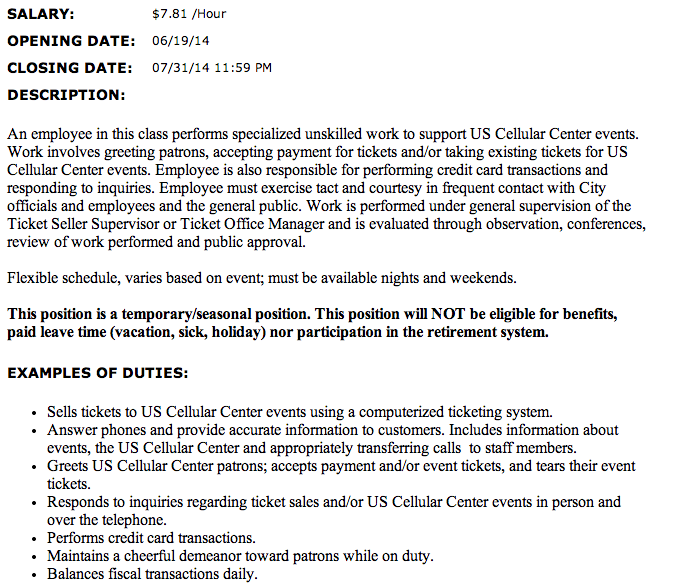


While Council is set to pass a budget tonight, it will still be months before it’s clear if all city workers will actually get a living wage
Above: the description of a U.S. Cellular Center job from the city of Asheville’s website last year, paying below a living wage.
Asheville City Council is set to pass a budget at its meeting tonight (5 p.m. on the second floor of City Hall), voting on how to spend roughly $154 million. The Blade has followed the budget process extensively, and this year’s has seen plenty of debate about everything from sidewalks to taxes to funding local non-profits, including at Council’s last meeting.
Another major topic of debate has been increasing wages for about 150 to 300 city employees to a living wage rate. As determined by local nonprofit Just Economics, the living wage rate is the amount necessary to make ends meet without public or private assistance. It’s currently set at $12.50 an hour without health insurance or $11 with.
While the city has had a living wage policy since 2007, it exempts “temporary and seasonal” workers, a category that includes everyone from Civic Center concessionaires to Parks and Rec laborers. A Blade investigation late last year revealed that (at the time) about 140 people in that category were making below, sometimes well below, a living wage. City staff have since estimated that, depending on the time of year, about 150 to 300 workers are considered “temporary/seasonal.”
Despite the name, some of the workers are neither temporary or seasonal: the category applies to all city employees that work 20 hours or less a week, even if they work during every season and even if they’ve worked for the city for years, or even decades.
Earlier this year, a majority of Council indicated that they wanted to change this, with some specifying they wanted to ensure all city workers make a living wage.
There’s $250,000 allocated for living wage increases, but have made no indication of how those raise will be distributed or even if they’ll cover all city employees. In fact, senior city staff have on several occasions noted that it likely won’t cover all city workers.
At the budget hearing, several speakers, including Vicki Meath, director of Just Economics, called on the city to extend a living wage to all city workers. At the same meeting Council member Cecil Bothwell said he wanted to see all city workers get a raise to a living wage, while Council member Gordon Smith said “walking the talk” on a living wage was a key priority for him, though he didn’t specify at the time if this meant all city workers would get a living wage.
So it’s been an important question of exactly how that $250,000 will be distributed and how many city employees will actually see a raise up to a living wage.
On Monday, after inquiries from the Blade, city spokesperson Polly McDaniel sent over the following statement:
Discussion over the budget in May saw some senior city staff indicate skepticism about the push for a living wage, and in some ways this wasn’t a new position.
In discussion of wages for temporary/seasonal workers with Council members last year, City Manager Gary Jackson warned of a “ripple effect” the might mean wages for other rank-and-file employees might need to rise.
In May 12 work session, Jackson again urged caution and said staff would “sharpen their pencils” to distinguish between which workers might get a living wage and which might not. This followed Linda Wishard, a consultant the city hired to assess its compensation plan, arguing against the concept of giving all city workers a living wage entirely, asserting that “it would falsely inflate your position in the marketplace.”
When the budget was presented on May 28, Chief Financial Officer Barbara Whitehorn noted to Council that “you all directed staff to look at our temporary, seasonal and part-time seasonal employees and determine which of those jobs should be at a living wage and which are truly temporary positions.”
“So that’s our goal,” she added.
On May 28, to further clarify the situation, I sent the following inquiry to Whitehorn:
The same day, Whitehorn responded with the following:
Given the latest reply, it may be months before the city’s “temporary/seasonal” workers see a raise and until the public finds out if, on this particular commitment, the city will still have some major exceptions.
—
The Asheville Blade is entirely funded by its readers. If you like our work, donate directly to us on Patreon. Questions? Comments? Email us.